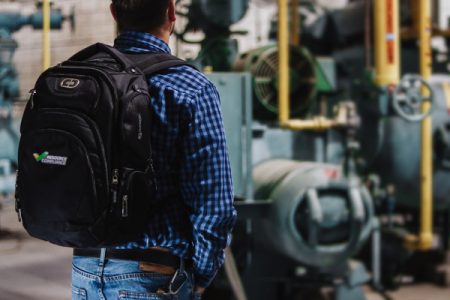Should I Hire a Contractor or Keep it In-House? | Part 4: Outsourcing Annual Inspections

Eli Macha presented a technical paper at the 2021 RETA National Conference titled IIAR 6: Should I Hire a Contractor or Keep it In-House? This blog series includes excerpts from his technical paper.
While there are always outliers, most facilities align on a couple key mechanical integrity items. What the data suggest is that there is one task which almost all facilities complete in-house and there is another task which almost all facilities outsource. This [blog] will explain the rationale behind [the second commonality].
Ever since the publication of IIAR’s Bulletin No. 109 IIAR Minimum Safety Criteria for a Safe Ammonia Refrigeration System in 1997, facilities have been completing detailed, annual inspections of their ammonia refrigeration systems according to the checklists found in this document. These inspections are often referred to as B-109s. Bulletin No. 109 was replaced in 2019 by ANSI/IIAR 6-2019 Standard for Inspection, Testing, and Maintenance of Closed-Circuit Ammonia Refrigeration Systems. Improved checklists are now available in Appendix B of IIAR 6.
One of the most frequent questions regarding the annual inspections is this: “Do I have to pay a contractor for the annual inspections?” The short answer is, “no.” Quite simply, there is no requirement for annual inspections to be outsourced. IIAR 6 has a simple requirement: “Equipment inspections shall be performed by a qualified inspector(s).” In the appendix, IIAR 6 provides some additional clarification: “Trained operators and/or trained technicians that have been verified by the owner to perform the annual inspections are considered qualified inspectors.”
While the simple answer is that annual inspections are not required to be outsourced, a further review of the requirements leads most facilities to hire contractors. Ultimately, it comes down to a judgment call. If the facility employs trained operators who can adequately complete the annual inspections, then the facility might be able to optimize their maintenance budget by completing the expensive activity in-house. On the other hand, while most facilities employ at least one operator whose primary responsibility is the refrigeration system, 39% of the facilities surveyed indicated they did not have any RETA-trained operators. While RETA training is not a requirement to perform the annual inspections, it is a good indicator of an operator’s skill level. Being able to perform the daily rounds does not necessarily qualify an operator to conduct the annual inspections. If a manager is unsure whether their operator can conduct the annual inspections, they could present the following list of activities to their operator to gauge their comfortability. These activities are some of the more advanced inspection items:
- Compressor: Visually inspect coupling for wear
- Condenser: Visually inspect water spray pattern from nozzles for sufficient water distribution
- Evaporator: Visually inspect the supports, fasteners, and mounting bolts for cracking, warping, stretching, bending, and looseness
- Piping: Visually inspect to verify all piping system openings, except relief discharge termination points, are plugged, capped, or locked closed with appropriate administrative controls
- Piping: Visually inspect ammonia refrigeration pipe labeling for correct placement, accuracy, and degradation
If the in-house operator feels confident with the above list, they may very well be qualified to perform the annual inspections.
One seemingly auxiliary skill associated with the annual inspections is report-writing. Anecdotally, one large freezing facility tasked an in-house operator with completing the annual inspections. At the end of all annual inspections, no recommendations were written. To most auditors, this would constitute a yellow or red flag. Outsourcing annual inspections to contractors practiced in writing reports will likely result in clear and actionable recommendations.
While the discussion thus far has covered annual inspections, annual tests have not yet been addressed. Consider the following list of annual testing items:
- Compressor: Test safety shutdowns – High discharge pressure cutout (HPCO)
- Compressor: Test safety shutdowns – High liquid level cutout
- Pump: Test safety shutdowns – Low liquid level cutout
- Emergency Ventilation: Expose ammonia detector(s) to calibration test gas and verify function of ventilation equipment
Most refrigeration contractors combine the annual tests with the annual inspections. If a facility does not want to outsource these annual tasks, they will also be responsible for testing various safety systems. Most facilities do not have operators trained to perform these tests, nor do they have the necessary equipment. As Maintenance Manager of a large production winery, Rene Soto, pointed out, “Contractors have the right shop setup to take care of these things. It wouldn’t make sense for us to have all that equipment.”
One hybrid method for handling annual inspections and tests appears to be gaining some popularity. Facilities can have their own experienced personnel complete the annual inspections, while relying on a refrigeration contractor to complete the annual testing activities. Oil analyses, vibration analyses, testing cutouts, testing high level float switches, calibrating ammonia sensors, etc. can all be completed by the contractor, while the time-consuming task of documenting inspections on all vessels, evaporators, and piping etc. can be addressed in-house.
Consider the following pros and cons list. As facilities make the best decision for their business, it may benefit them to use this list as a starting point and adjust according to their situation.

The previous blogs in this series are available in the following links:
- Part 1: Introduction
- Part 2: Research Methodology
- Part 3: Completing Daily Rounds In-House

Leave a Reply